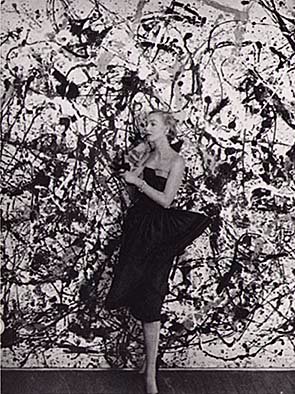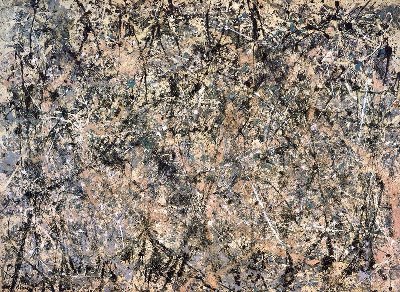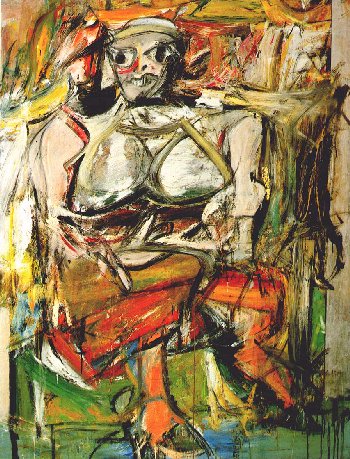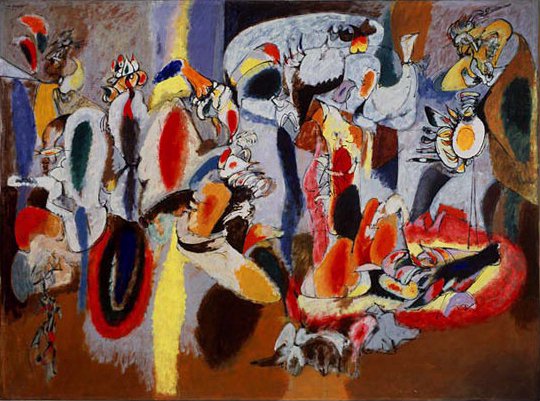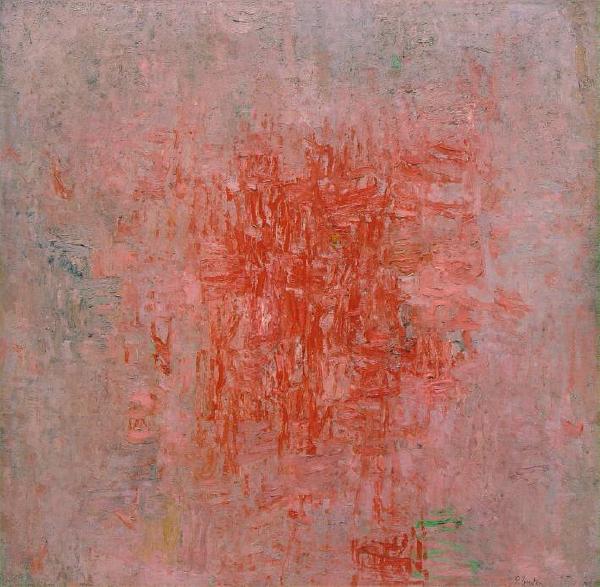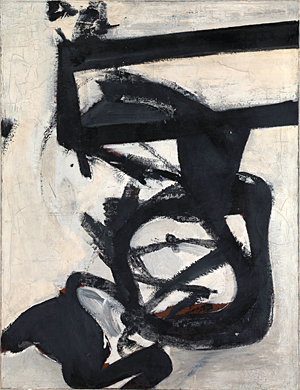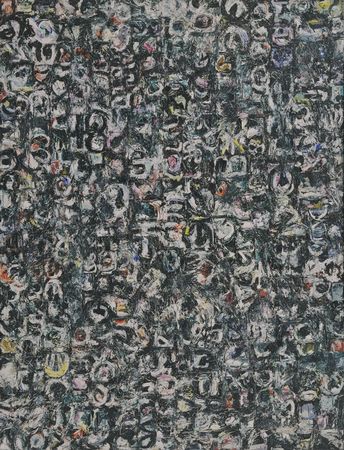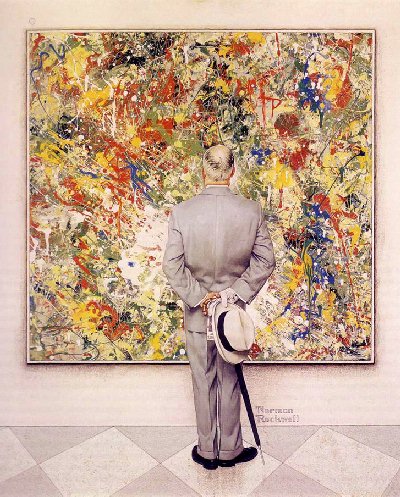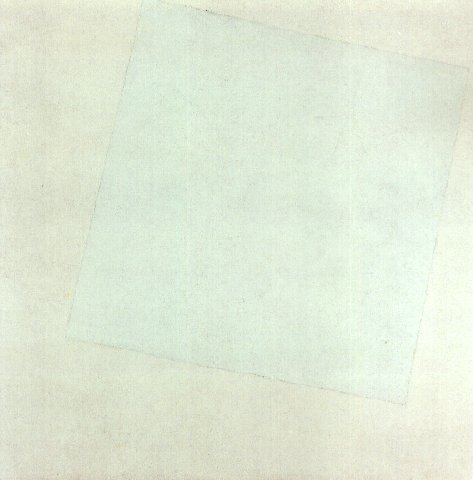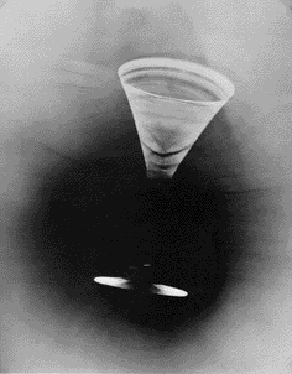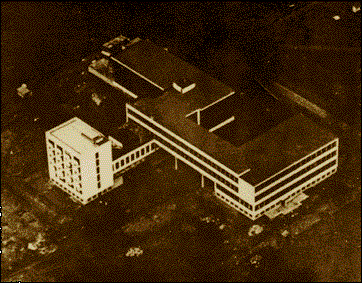 |
||||||
|
Abstract Expressionism
In Search of NothingnessBy Charles Moffat - January 2008. The term "Abstract Expressionism" was first used in Germany in connection with Rusian artist Wassily Kandinsky in 1919 (referencing the German Expressionists with their anti-figurative aesthetic), but later became more commonly associated with Post-WWII American Art. Alfred Barr was the first American to use this term in 1929, also in relation to the works by Wassily Kandinsky. Robert Coates (an American art critic) later popularized the term Abstract Expressionism by applying it to similar artists like Arshile Gorky, Jackson Pollock and Willem de Kooning. By the 1951 Museum of Modern Art exhibition 'Abstract Painting and Sculpture in America', the term was used to refer to all types of non-geometric abstraction. There are two major groups within Abstract Expressionism, which was influenced by Surrealism and Cubism: Colour Field Painters: Mark Rothko, Barnett Newman, Clyfford Still worked with simple, unified blocks of colour. Gestural Painters: Jackson Pollock, Willem de Kooning and Hofmann used Surrealist techniques of automatic art. Not all the artists associated with the term produced either purely abstract or purely Expressionist work, but would sometimes delve into more realistic portrayals of objects or people. The term "Abstract Expressionism" was also difficult to understand. Harold Rosenburg preferred the phrase "Action Painting" and art critic Clement Greenberg preferred "American Type Painting". Because of the concentration of Abstract Expressionism artists in New York it was also known as the New York School. Abstract Expressionism was the first specifically American movement to achieve worldwide influence and also put New York City at the center of the art world, a role formerly filled by Paris. The key unifying factor for all the artists was their exploration of the avant garde of abstraction. Publications like "Tiger's Eye", an avant garde magazine, helped spread their Creationist/Existential ideas was an important part of the movement. Abstract Expressionists sought to express their subconscious through their art and shared an interest in Jung's ideas on myth, ritual and memory. Quite a few had a Surrealist background, having been inspired by the presence of Breton, Masson and Matta in New York in the 1940s and by retrospectives on the Surrealist Miró and Kandinsky. Some of the artists saw themselves as disillusioned commentators on contemporary society after the Great Depression and the Second World War. As a movement the Abstract Expressionists were seen as rebels and sometimes even troublemakers. The extreme censorship of the McCarthy era after World War II was a hot topic amongst artists and because of the sheer abstraction the artists could not be censored because there really nothing in the paintings to censor. The movement gained recognition largely due to the fame of Jackson Pollock and a Time Magazine article claiming him to be greatest living artist in America. Pollock's purely abstract work polarized the public and the art critics and provoked discussions of "What is art?" and "Is that art?"
Aftermath of Abstract ExpressionismJean-Paul Riopelle first introduced Abstract Expressionism to Europe in Paris in the 1950s. Two years later art curator Michel Tapié's groundbreaking book "Un Art Autre" was enormously influential in promoting the movement in Europe. Tapié promoted the works of Pollock and Hans Hoffman in exhibitions across Europe. By the 1960s the movement's initial affect had been assimilated, yet its methods and proponents remained highly influential in art, affecting profoundly the work of many artists who followed. All the art movements of the 1960s (Tachisme, Color Field painting, Lyrical Abstraction, Fluxus, Pop Art, Minimalism, Postminimalism, Neo-expressionism) would be influenced by Abstract Expressionism.
Samples of Abstract Expressionism
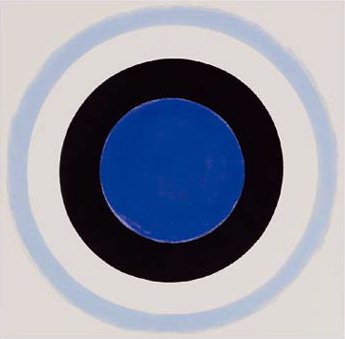
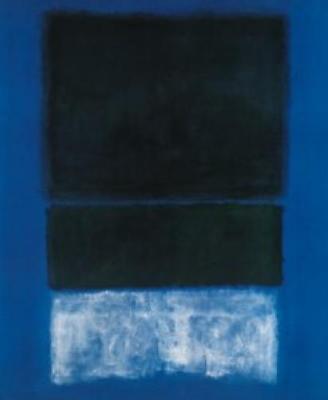
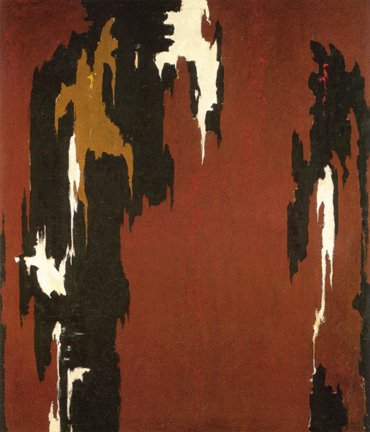
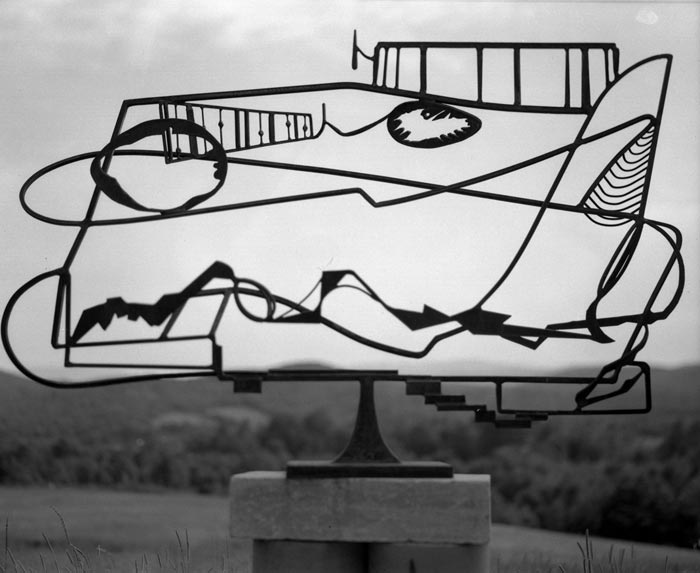
The Surrealist Origins of Abstract ExpressionismOver fifty years have passed since Abstract Expressionism burst onto the New York City art scene, quickly attaining singular prominence as the first school in American painting to declare its independence from European styles. New assessments of its impact and importance continue to emerge. Yet, while much has been written about the movement's broad range of stylistic diversity, its sociological and psychological dimensions, and its cultural significance in the United States, little attention has been paid to the interaction of its artists on the international scene. Abstract Expressionism: The International Context fills this gap by providing an in-depth exploration of this truly global art movement. In the late 1930s and early 1940s, around the outbreak of World War II, many Surrealists fled Europe and settled in New York. Their interest in unmediated expression to reach the absolute soon influenced a young generation of painters struggling to find a voice for American art. The new movement, which became known as Abstract Expressionism, was heavily indebted to the ideas of the European pioneers of abstraction, including Vasily Kandinsky, whose work was championed in influenced a young generation of painters struggling to find a voice for American art. The new movement, which became known as Abstract Expressionism, was heavily indebted to the ideas of the European pioneers of abstraction, including Vasily Kandinsky, whose work was championed in this country by the Museum of Non-Objective Painting (subsequently renamed the Solomon R. Guggenheim Museum) beginning in 1939. Many of the Abstract Expressionists celebrated spontaneity and the exploration of the self in large paintings bursting with free form and gestural brushwork. The movement s free-wheeling spirit and its unbridled, heroic energy are exemplified both by Jackson Pollock's method of dripping paint directly onto the canvas in an improvisational act of art m aking and by Willem de Kooning's slashing of form and agitated brushstrokes. However, other artists associated with the movement avoided gesture and emphasized their paintings flatness. Barnett Newman, for example, explored the expression o f the sublime through large expanses of color interrupted by zips, one or more vertical lines of contrasting hue. Mark Rothko's brooding compositions, such as White Band (No. 27) (1954), represent a hybrid of gesture painting and the use of color fields. And the monochromatic paintings of Ad Reinhardt hark back to works by Kazimir Malevich and Piet Mondrian, in which pure color and geometric order provoke deep contemplation.
The Role of the CriticsRight: Norman Rockwell - The Connoisseur - 1962 In the 1940s there were not only few galleries (The Art of This Century) but also few critics who were willing to follow the work of the New York Vanguard. There were also a few artists with a literary background, among them Robert Motherwell and Barnett Newman who functioned as critics as well. While New York and the world were yet unfamiliar with the New York avant-garde by the late 1940s, most of the artists who have become household names today had their well established patron critics: Clement Greenberg advocated Jackson Pollock and the color field painters like Clyfford Still, Mark Rothko, Barnett Newman, Adolph Gottlieb and Hans Hofmann. Harold Rosenberg seemed to prefer the action painters like Willem de Kooning, Franz Kline and Louis Schanker. Thomas B. Hess, the managing editor of Art News, championed Willem de Kooning. The new critics elevated their proteges by casting other artists as "followers" or ignoring those who did not serve their promotional goal. As an example, in 1958, Mark Tobey "became the first American painter since Whistler (1895) to win top prize at the Biennale of Venice. New York's two leading art magazines were not interested. Arts mentioned the historic event only in a news column and ARTnews (Managing editor: Thomas B. Hess) ignored it completely. The New York Times and Life printed feature articles." Barnett Newman, a late member of the Uptown Group wrote catalogue forewords and reviews and by the late 1940s became an exhibiting artist at Betty Parsons Gallery. His first solo show was in 1948. Soon after his first exhibition, Barnett Newman remarked in one of the Artists' Session at Studio 35: "We are in the process of making the world, to a certain extent, in our own image." Utilizing his writing skills, Newman fought every step of the way to reinforce his newly established image as an artist and to promote his work. An example is his letter in April 9, 1955, "Letter to Sidney Janis: — it is true that Rothko talks the fighter. He fights, however, to submit to the philistine world. My struggle against bourgeois society has involved the total rejection of it." Strangely the person thought to have had most to do with the promotion of this style was a New York Trotskyist, Clement Greenberg. As long time art critic for the Partisan Review and The Nation, he became an early and literate proponent of abstract expressionism. Artist Robert Motherwell, well heeled, joined Greenberg in promoting a style that fit the political climate and the intellectual rebelliousness of the era. Clement Greenberg proclaimed abstract expressionism and Jackson Pollock in particular as the epitome of aesthetic value. It supported Pollock's work on formalistic grounds as simply the best painting of its day and the culmination of an art tradition going back via Cubism and Cézanne to Monet, in which painting became ever 'purer' and more concentrated in what was 'essential' to it, the making of marks on a flat surface. Jackson Pollock's work has always polarised critics. Harold Rosenberg spoke of the transformation of painting into an existential drama in Pollock's work, in which "what was to go on the canvas was not a picture but an event". "The big moment came when it was decided to paint 'just to paint'. The gesture on the canvas was a gesture of liberation from value — political, aesthetic, moral." One of the most vocal critics of abstract expressionism at the time was New York Times art critic John Canaday. Meyer Shapiro, and Leo Steinberg along with Clement Greenberg and Harold Rosenberg were important art historians of the post-war era who voiced support for abstract expressionism. During the early to mid sixties younger art critics Michael Fried, Rosalind Krauss and Robert Hughes added considerable insights into the critical dialectic that continues to grow around abstract expressionism. Other people, such as British comedian/satirist Craig Brown, have been astonished that decorative 'wallpaper' could gain such a position in art history alongside Giotto, Titian and Velazquez.
Abstraction in the Twentieth CenturyIn the same way that manned flight and other technological breakthroughs embody the intellectual achievement and adventurous outlook of the twentieth century, so too does abstraction. With its decisive rejection of recognizable imagery in favor of felt experience, abstraction, unlike all other styles and movements, has transcended transitory and local interests, serving as a viable choice to international artists for the past eighty-five years. It is the defining style of the century as well as a sign of our place in history. Through its bold and visionary spirit, abstraction also evokes how art might proceed into the future. Evolving after photography had proven its ability to capture appearances, abstract painting and sculpture convey what cannot be viewed through a lens. Abstractionists have challenged themselves to depict the unseeable rhythms of nature, the ineffable qualities of life, the heroic capacities of individuals and society, or the vast if vague regions of the soul. In this sense, these artistic revolutionaries have neither discarded the desire to communicate content to the viewer nor rejected the connection of their highly expressive art form to life. But the nonreferentiality of abstract art requires the viewer to plumb new emotional reservoirs in order to absorb and to be touched by it. Variously explosive, serene, intense, or contemplative, abstraction offers kinds of beauty unimaginable in earlier art. That this exhibition which progresses upward along the spiral ramp and into the Tower galleries is being presented by the Solomon R. Guggenheim Museum is particularly appropriate given its history. Inaugurated as the Museum of Non-Objective Painting in 1939, the institution exhibited the work of the great pioneers of abstraction in particular that of Vasily Kandinsky and played a major role in disseminating the new art style in the United States. In recents years a lack of artistic discipline and too many amateur artists having given abstraction a bad name. See Abstraction: Perfection and Amateurism.
Freedom, Risk & DisciplineEva Hesse's description of her approach to art making is an apt summary of the abstract project in general. To reject the comfortable accessibility of representation has required a high degree of daring. Artists who employ this revolutionary approach are like tightrope walkers who eschew safety nets. But their risk taking has one paramount reward: complete freedom from conventional concerns and constraints, which can lead to unfettered expressiveness and individual exaltation. Yet however spontaneous their works may appear, abstract artists employ highly calculated methods. Like jazz musicians imaginatively improvising within a chord structure, abstract artists must make disciplined use of materials to communicate with the viewer. Hesse's words ring true, then, as a kind of anthem of abstraction.
Pioneering the StyleVasily Kandinsky, Kazimir Malevich, and Piet Mondrian are considered to be the first artists to have achieved a truly abstract visual language in painting. By the early to mid-1910's, they had created compositions that ceased to function as reflections of reality. Although they worked independently from one another, these artists were united by a belief that abstract (or non-objective) painting was capable of evoking a spiritual experience. Expressing themselves through philosophical writings as well as paintings, they practiced art as a metaphysical quest for higher truth. A central figure of German Expressionism, Kandinsky made his breakthrough to abstraction around 1911, when he began to paint densely layered compositions of free-floating lines and areas of color. Their titles, such as Improvisation and Composition, reveal his desire to instill visual form with the properties of music. In some of these early abstract works, for example Painting with White Border (1913), landscape elements like hills and trees can still be discerned, but their features have been reduced to a lyrical mosaic of line and color. By 1915, Malevich had invented a new, abstract visual language that he called Suprematism the name he gave to paintings consisting of one or more colored geometric shapes on a white field. Malevich wrote of visualizing a state of feeling, of creating through abstract painting a sense of bliss and wonder. Thus, his works often contain unanchored forms that are meant to evoke sensations of floating or flying, as if to make the viewer imagine being transported to another dimension. Mondrian also took a reductive approach to form, but one with a tighter geometric orientation and stricter compositional order. Like Kandinsky, Mondrian was inspired by landscape, but he interpreted it in his earliest abstract paintings as a series of interlocking vertical and horizontal lines. A principal member of the De Stijl group a loose confederation of artists and architects who attempted to integrate art, design, and architecture with a unified, rigorous approach to form Mondrian reduced elements to their purest state, creating geometrically ordered and balanced compositions that he viewed as expressions of universal harmony.
Monochrome PaintingThe origins of monochrome painting lie early in the century, when Kazimir Malevich painted a white square on a white field in 1918. As an expression of a pure state of feeling, Malevich's painting offered a beacon of hope for abs tract painting s spiritual potential. Just three years later, Aleksandr Rodchenko exhibited a red, a yellow, and a blue painting, declaring that together they represented the final statement that could be made in the medium and thus signified the d eath of easel painting. These dual identities of monochrome painting as a vehicle for spiritual redemption and as the absolute end of painting have ebbed and flowed throughout the century. Right: Kazimir Malevich - Suprematicist Composition: White on White - 1918 In France during the late 1950's and early 1960's, Yves Klein investigated monochrome as a painting of nothingness. His ultramarine canvases were the representation of the immaterial, the sovereign liberation of the spirit. Klein's investment of spiritual content in art stands in direct conflict with the more popular notion of painting as object, the object being an end in itself. One of the earliest manifestations of this sentiment in painting is the work of Frank Stella, whose frequently cited statement What you see is what you see encapsulates Minimalism's adoption of a pure abstraction devoid of any spiritual or metaphysical connotations. Minimalism emphasizes the materiality and shape of the object and denies any sense of personal touch in the work's execution. Such strategies are evident in Hard-edge paintings by Ellsworth Kelly and mon ochrome works by Robert Ryman. Kelly explores mass, color, and form through flatly painted shaped canvases of one color or multiple panels in different colors, which seem to dissolve into their surrounding space, denying the traditional edge of a painting s surface. The most complex investigation into monochrome has been undertaken by Ryman, who, since the mid-1960s', has diligently pursued various permutations of all-white painting, realizing an astonishing range of expression within a seemingly limited set of criteria.
Abstraction in PhotographyDuring the first half of the twentieth century, a number of abstract artists who were working simultaneously in several different mediums praised photography as the most progressive means of expression. Right: Laszlo Moholy-Nagy - Photogram: Wine Glass - 1938 Requiring the mediation of a mechanical device the camera and chemical solutions, photography represented the ultimate Modernist art form, for science and technology were essential to the artwork s creation. Lazlo Moholy-Nagy, a Hungarian artist wh o first came to prominence as a teacher at the Bauhaus in Germany, is among those credited with producing the first non-objective photographs. Pursuing what he called the new vision an art appropriate to the modern age Moholy-Nagy produced abstract works in various mediums, including painting, sculpture, film, design, and photography. His sustained interest in light, space, and motion l ed him to make photograms, photographs created without a camera by arranging objects directly on light-sensitive paper, which is then exposed to light in bursts or for sustained periods. By shifting the arrangement and repeating the process with the same piece of paper, Moholy-Nagy produced ethereal traces of an object s form and its movement across the paper, while disguising its original identity. He created the impression of three-dimensional form by varying the density of lights and darks across the image surface, a technique he could also use to make an object appear either transparent or opaque.
Abstraction in ArchitectureThe relationship between abstract art and Modernist architecture was particularly strong in the early twentieth century. Many painters paid homage to architectural principles in their abstract compositions. Some, such as Kazimir Malevich in works he called architectonics, went so far as to experiment with three-dimensional extrapolations of ideas first explored in paintings. Right: Walter Gropius - Bauhaus Buildings, Dessau - 1926 A number of artistic groups and movements evolved around the formation of polytechnic schools, which taught the integration of art, architecture, and design. The most famous of these was the Bauhaus, founded in Weimar, Germany in 1919 by architect Walter Gropius. His design for the school s buildings in Dessau (constructed in 1926), a series of interlocking geometric forms around a central matrix, embodies the transformation of an abstract, planar composition into a functioning, three-dimensional form. One of the great landmarks of the twentieth century, Gropius' Bauhaus buildings exemplify the primary tenets of Modernist architecture: the celebration of industrial materials and construction techniques, and the banishing of ornament and handcrafted elements in favor of a sleek, machinelike aesthetic.
|
|
|||||
|
|
||||||
|
|
||||||
 |
|
 |
||||
